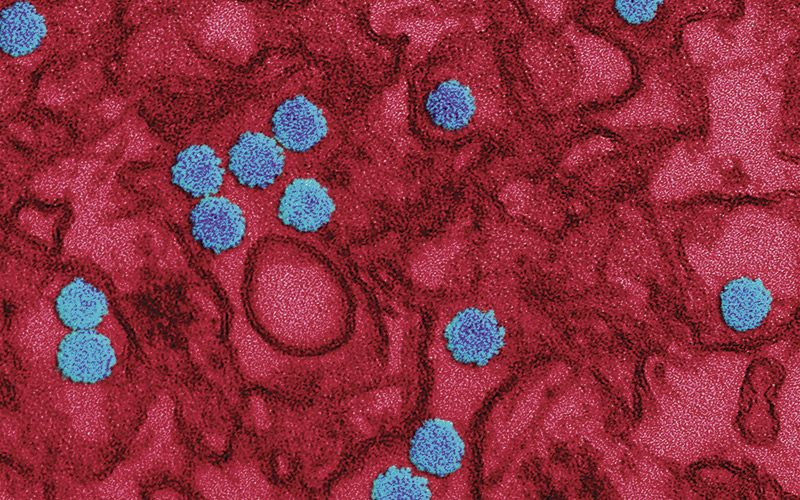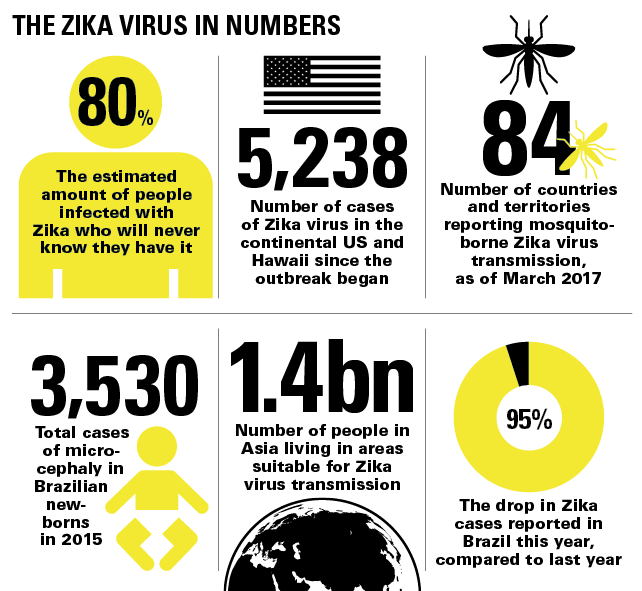Brazil has just announced that the Zika virus is no longer a public health emergency. We look back at the outbreak and forward to the attempts to create a vaccine.

Fig. 1. (above) Coloured transmission electron micrograph of Zika virus particles (blue)
Eighteen months ago the outbreak of the Zika virus made headlines around the world. It had not been considered a major health threat until the realisation that it could lead to severe birth defects, particularly the congenital condition microcephaly.
Pictures of babies suffering from the condition caused panic to spread, as the virus advanced and cases were reported in dozens of countries. Trips were cancelled to those places hit hardest by the virus, especially Brazil, which was at the centre of the outbreak and was gearing up for the 2016 Olympics.
The country declared a “national emergency” in November 2015, following which the World Health Organisation (WHO) classed the Zika virus as an international medical emergency.
End to the emergency
The infection has since been linked to severe birth defects in almost 30 countries, with more than 2,100 cases of nervous-system malformations reported in Brazil alone.
However, in May this year Brazil announced an end to the public health emergency. The news came as figures showed that in January to mid-April this year, 95% fewer cases were recorded than during the same period last year. The incidence of microcephaly fell too.
The WHO has also changed Zika’s status, but is still classing it as a “significant and enduring threat”. David Heymann, Chairman of the Zika virus Emergency Committee, says: “We are not downgrading the importance of Zika. By placing this as a long-term programme of work, we are saying Zika is here to stay.”
Dr Peter Salama, WHO Director of Emergencies, believes that the imminent threat may not be as severe, but that we are entering a new phase of fighting the virus, “which is a long-term problem that the world will have to deal with for many years to come [...] Zika is here to stay and the WHO’s response is robust.”
The history of the Zika virus
1947: Scientists identify a new virus in a rhesus monkey in the Zika forest of Uganda.
1952: The first human cases of Zika are detected in Uganda and the United Republic of Tanzania.
1964: A researcher in Uganda is infected with Zika while working on the virus, confirming that it causes human disease. He reports the illness as “mild”.
1969: Zika virus is detected in mosquitoes in equatorial Asia. 2007The first large Zika outbreak in humans happens on the Pacific island of Yap, with an estimated 73% of residents infected.
2013: Outbreaks occur in other Pacific islands: French Polynesia, Easter Island, the Cook Islands, and New Caledonia.
2015: In May, Brazil’s National Reference Laboratory confirms Zika virus is circulating in the country.
October: Brazil reports an unusual increase in the cases of microcephaly in newborns.
November: National public health emergency declared as cases of suspected microcephaly increase.
2016: First diagnoses of intrauterine transmission of the Zika virus in two pregnant women in Brazil.
Three potential vaccines
Despite the good news for Brazil, the global threat still looms large, and the drive to create a vaccine against Zika continues apace. While it will be years before they are available to the public, three potential vaccines are being tested in humans at present. Two are based on cutting-edge DNA vaccine technology, and the third is based on the more standard inactivated virus model.
The DNA vaccines under development interfere with the virus’ ability to enter cells and replicate itself, while the inactivated vaccine aims to create an immune response that would provide future protection against Zika.
Of the three, a DNA vaccine developed by the US National Institutes of Health has progressed the furthest to date, with a large multi-site phase 2 trial underway involving almost 2,500 test subjects.
Stephen Thomas is a Professor of Infectious Disease at the State University of New York Upstate Medical University in Syracuse. He is also one of the authors of a paper published in the journal Immunity, which reviews how the three vaccines are progressing.
He states that the pace of research and development has been “incredibly brisk” and that “some groundbreaking strides have been made in very short periods of time.”
But he stresses that “it is a very large chasm between animal data and what translates into a safe and efficacious vaccine for humans”. The paper also reinforces this. It concludes: “The development of a safe and effective vaccine is an urgent global health priority. Promising data from preclinical vaccine studies in mice and monkeys suggest that an effective vaccine will likely be possible, but important scientific challenges remain.”





